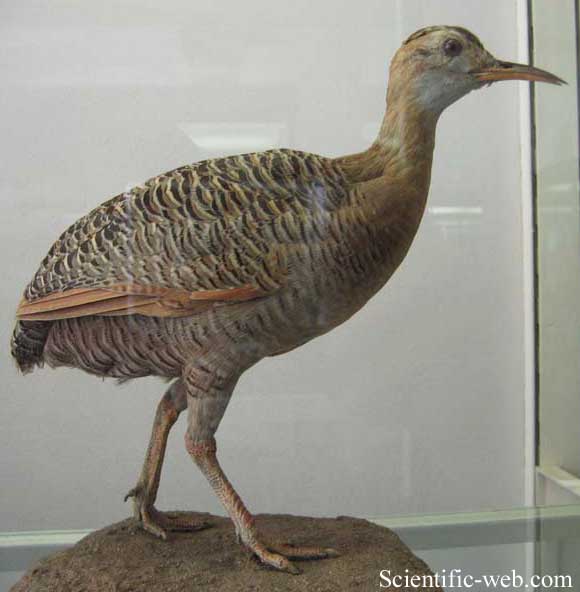
Rhynchotus rufescens, Photo: Michael Lahanas
Superregnum: Eukaryota
Cladus: Unikonta
Cladus: Opisthokonta
Cladus: Holozoa
Regnum: Animalia
Subregnum: Eumetazoa
Cladus: Bilateria
Cladus: Nephrozoa
Superphylum: Deuterostomia
Phylum: Chordata
Subphylum: Vertebrata
Infraphylum: Gnathostomata
Megaclassis: Osteichthyes
Cladus: Sarcopterygii
Cladus: Rhipidistia
Cladus: Tetrapodomorpha
Cladus: Eotetrapodiformes
Cladus: Elpistostegalia
Superclassis: Tetrapoda
Cladus: Reptiliomorpha
Cladus: Amniota
Classis: Reptilia
Cladus: Eureptilia
Cladus: Romeriida
Subclassis: Diapsida
Cladus: Sauria
Infraclassis: Archosauromorpha
Cladus: Crurotarsi
Divisio: Archosauria
Cladus: Avemetatarsalia
Cladus: Ornithodira
Subtaxon: Dinosauromorpha
Cladus: Dinosauriformes
Cladus: Dracohors
Cladus: Dinosauria
Ordo: Saurischia
Cladus: Eusaurischia
Subordo: Theropoda
Cladus: Neotheropoda
Cladus: Averostra
Cladus: Tetanurae
Cladus: Avetheropoda
Cladus: Coelurosauria
Cladus: Tyrannoraptora
Cladus: Maniraptoromorpha
Cladus: Maniraptoriformes
Cladus: Maniraptora
Cladus: Pennaraptora
Cladus: Paraves
Cladus: Eumaniraptora
Cladus: Avialae
Infraclassis: Aves
Cladus: Euavialae
Cladus: Avebrevicauda
Cladus: Pygostylia
Cladus: Ornithothoraces
Cladus: Ornithuromorpha
Cladus: Carinatae
Parvclassis: Neornithes
Cohors: Palaeognathae
Ordo: Tinamiformes
Familia: Tinamidae
Subfamilia: Rhynchotinae
Genus: Rhynchotus
Species: Rhynchotus rufescens
Subspecies: R. r. catingae – R. r. pallescens – R. r. rufescens
Name
Rhynchotus rufescens (Temminck, 1815)
Original combination: Tinamus rufescens
References
Histoire naturelle générale des pigeons et des gallinaces. 3 p. 552, 747
Vernacular names
čeština: Tinama inambu
English: Red-winged tinamou
español: Martineta alas coloradas, Tinamú alirrojo
lietuvių: Raudonsparnis tinamas
português: Perdiz, perdigão
svenska: Rostvingad tinamo
The red-winged tinamou (Rhynchotus rufescens) is a medium-sized ground-living bird from central and eastern South America.[3] Other common names for the species include perdiz grande, rufous tinamou, and ynambu.
Taxonomy
All tinamou are from the family Tinamidae, and in the larger scheme are also ratites. Unlike other ratites, tinamous can fly, although in general, they are not strong fliers. All ratites evolved from prehistoric flying birds, and tinamous are the closest living relative of these birds.[4]
Coenraad Jacob Temminck first identified the red-winged tinamou from a specimen from São Paulo state, Brazil, in 1815.[4]
Subspecies
The red-winged tinamou has three subspecies:
R. r. rufescens, the nominate race, occurs in southeastern Peru, Bolivia, eastern Paraguay southeastern Brazil and northeastern Argentina,[3] and possibly Uruguay[4]
R. r. catingae occurs in central and northeastern Brazil[3]
R. r. pallescens occurs in northern Argentina; eastern Formosa, Chaco, Santa Fé, Córdoba, La Pampa, Buenos Aires, Entre Ríos, Corrientes, and Rio Negro[3]
Previously, the taxon maculicollis was considered a subspecies of the red-winged tinamou, but following SACC it is now considered a species in its own right; the huayco tinamou.[5]
Etymology
Its common name refers to the bright rufous primaries, which mainly are visible in flight.
Description
The red-winged tinamou is approximately 40 to 41 cm (15.7–16.1 in) in length, and weighs 830 g (29 oz), and the female may be slightly larger. It has a black crown, rufous primaries, and light gray to brown underneath. It may have black bars on flanks, abdomen and vent.[4] Also, the throat is whitish, the foreneck and breast are cinnamon. The curved bill is horn-coloured with a blackish culmen. Juveniles are duller.
Range
Its range is southeastern, northeastern and central Brazil, eastern Paraguay, southeastern Peru, Bolivia and eastern Argentina[3]
Habitat
At lower elevations (1,000 m (3,300 ft)), it favours marshy grasslands (seasonally flooded) and forest edges. While, at higher elevations, up to 2,500 m (8,200 ft), it will frequent arid shrubland, pastures, and grain fields.[4][6] Overall it prefers dry savanna.[6]
Behavior
The red-winged tinamou have vocal males that are a longs ringing single whistle followed by shorter sad whistles. The female does not call. This species is most active during the hottest parts of the day.[4]
Feeding
Its diet varies by season; it taking insects and other small animals (even small mammals) in the summer, and switching to vegetable matter, such as fruits, shoots, tubers and bulbs, in the winter. It can be an agricultural pest, feeding on cereals, rice and peanuts, as well as being predatory, taking poisonous snakes and even jumping up into the air to snatch an insect off a leaf.
Reproduction
The male of the species attracts the female by follow feeding and after the attraction will move to the nest where she lays her eggs that he will incubate only and then raise the chicks.[4]
Conservation
Like all tinamous, the red-winged tinamou is a popular target for hunters, and in areas of high human population density number have declined, but the species has also increased in some areas where forest clearance has created favourable habitat. Overall, it is not considered threatened and is therefore listed as Least Concern by IUCN.[1] It has an occurrence range of 5,700,000 km2 (2,200,000 sq mi).[6]
Footnotes
BirdLife International (2016). "Rhynchotus rufescens". IUCN Red List of Threatened Species. 2016: e.T22733941A95069901. doi:10.2305/IUCN.UK.2016-3.RLTS.T22733941A95069901.en. Retrieved 11 November 2021.
Brands, S. (2008)
Clements, J (2007)
Davies, S. J. J. F. (2003)
Remsen Jr., J. V. (2000)
BirdLife International (2008)
References
BirdLife International (2008). "Red-winged Tinamou - BirdLife Species Factsheet". Data Zone. Retrieved 9 Feb 2009.
Brands, Sheila (Aug 14, 2008). "Systema Naturae 2000 / Classification, Rhynchotus rufescens". Project: The Taxonomicon. Retrieved Feb 9, 2009.
Clements, James (2007). The Clements Checklist of the Birds of the World (6th ed.). Ithaca, NY: Cornell University Press. ISBN 978-0-8014-4501-9.
Davies, S.J.J.F. (2003). "Tinamous". In Hutchins, Michael (ed.). Grzimek's Animal Life Encyclopedia. Vol. 8 Birds I Tinamous and Ratites to Hoatzins (2nd ed.). Farmington Hills, MI: Gale Group. pp. 57–59, 64–65. ISBN 0-7876-5784-0.
del Hoyo, J., Elliot, A., Sargatal, J., eds (1992) Handbook of the Birds of the World, Volume One Ostrich to Ducks, ISBN 84-87334-10-5
Remsen Jr., J. V.; et al. (4 Oct 2000). "Proposal to South American Checklist Committee (#2000-01)". South American Classification Committee. American Ornithologists' Union. Archived from the original on 2012-12-12. Retrieved 4 Feb 2009.
Retrieved from "http://en.wikipedia.org/"
All text is available under the terms of the GNU Free Documentation License

